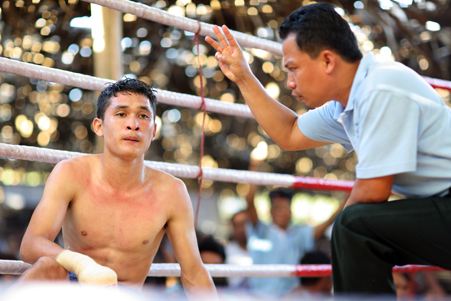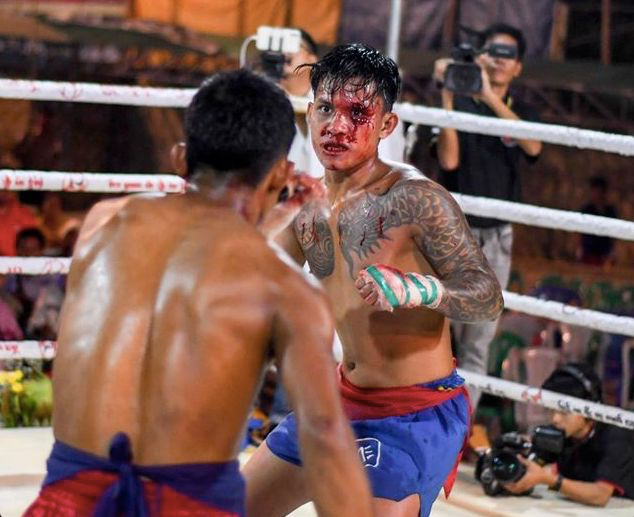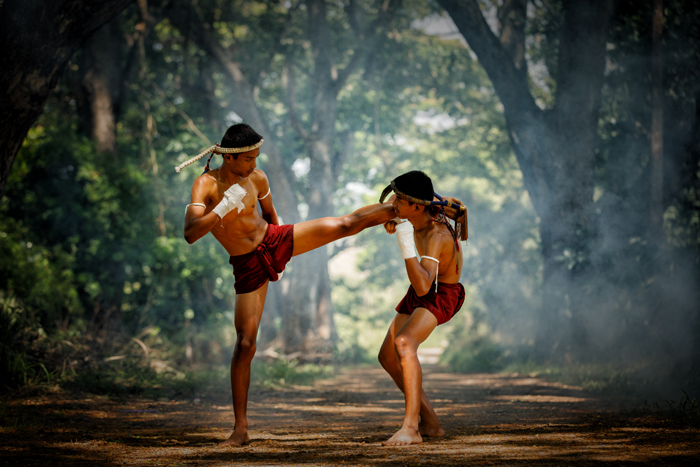Lethwei: The World of Burmese Bare Knuckle Boxing
Table of Contents

Lethwei is an ancient form of Burmese bare-knuckle boxing that has caught the eyes of many fascinated martial arts fans around the world. It is a tough sport where only the most durable and talented fighters have a path to success.
Lethwei is a sport that cannot lie; the damage is shown through cuts, bruises, broken bones, and knockouts. Its pureness has captivated the imagination of many martial arts students and fight fans around the world. Join me in this post, where I uncover the brutal yet beautiful sport of Lethwei!
A Brief History of Lethwei
Lethwei is an ancient form of boxing that was designed to serve as entertainment for the ancient kingdoms of Myanmar. This form of Burmese bare-knuckle boxing was encompassed under a broad term for Burmese martial arts called “Thaing.” It was a name used to describe many kinds of Burmese fighting styles at the time; these include Bando, Banshay, Naban, Shan Gyi, and, of course, Lethwei.
Lethwei was a sport that was watched by all the folks of the ancient Burmese Kingdoms. Fights would usually take place without protective gear, or sometimes fighters would wrap their hands with hemp or gauze. Under British colonial rule, Lethwei fights lessened in occurrence as they were not seen as appropriate. However, once the British had left Burma, Lethwei began to become formalized as a popular sport.
In 1995, the Myanmar Lethwei Federation was established, a government brand of the ministry of health and sports. The name was later changed in 2019 to the Myanmar Traditional Lethwei Federation. This organization was crucial in formalizing Lethwei, and today it has become a much-appreciated sport with many fans and practitioners worldwide.
Techniques Permitted in Lethwei

Lethwei has a very relaxed ruleset, and almost any type of striking is allowed. Listed below are the techniques that are allowed to be used in a Lethwei match:
- Punches
- Kicks
- Knees
- Elbows
- Headbutts
- Clinching
- Sweeps
- Throws
These techniques have almost no confines, unlike some other sports where you may be allowed to knee or elbow, but only in certain situations. With the exception of ground fighting, Lethwei does not limit its fighters, which makes Lethwei very interesting to watch as anything can happen. This has resemblance to Muay Thai, but Lethwei adds in headbutts, and fighters do not wear gloves.
Traditional Lethwei Rules

Matches with traditional rules are frequently held in Burma. These rules are known as yoe yar rules, a name that is derived from the Burmese term Myanma yoe yar Latway; in English, this means Myanmar Traditional Boxing. These traditional Lethwei fights have a strict knockout-only rule while also having unique fight attire and timing of the fight. Let’s check out the rules and format of a Lethwei fight.
The Lethwei Knockout Rule
- A fighter is counted out for 20 seconds. This is called a 10-count but has two seconds between each count.
- Three 20-second counts in one round are considered a loss, and the fighter will score a knockout victory.
- A fighter has fallen to the ring without getting up for the 10-count.
- A fighter cannot defend themselves for a 10-count (20 seconds). This could be standing, as some 10 counts happen while both fighters are still standing. Usually, a technical knockout victory (TKO) will be declared.
- A fighter has suffered severe damage, which may impair their ability to continue the fight. This is counted as a technical knockout.
- If a fighter has scored four 10 counts within one fight, then the fight is called off and a victory will be given to the fighter.
The Lethwei knockout rule is something special, as no other sport has such a rule. It allows for very high-intensity matches and keeps you at the edge of your seat. I believe it’s one of the attributes that makes Lethwei matches so exciting.
Rounds in a Lethwei Fight
- Lethwei fights are different from boxing, Muay Thai, or kickboxing, and the rounds are set up differently. This depends on who is fighting and if a belt is on the line or not.
- Fights can be scheduled for three, four, or five rounds, lasting three minutes each.
- There is a 2-minute break between each round.
- Championship fights last five rounds, three minutes each, with a two-minute intermission in between.
This is unique in comparison to other combat sports, as Muay Thai kickboxing and MMA will not take such long breaks between rounds. Lethwei fighters are able to recover slightly between these rounds and go back out there full of energy. This might be the reason Lethwei fights are so intense.
What Do Fighters Wear in Lethwei Fights?
- The warriors are limited to wearing electrical tape, gauze, and tape on their hands and feet.
- The warriors will not be wearing shoes or shirts—just shorts.
- The combatants need to have groin guards on.
- Gloves are forbidden under Burmese bareknuckle boxing rules.
- A gum barrier is required for the warriors.
- The boxers must apply the wrapping in front of the referees, who will then approve it.
The fighting attire for a Lethwei fight has a few restrictions. As this is a bare-knuckle boxing fight, fighters wear attire designed around this.
Lethwei Training Methods

Lethwei training is quite similar to kickboxing and Muay Thai training. It consists of hitting pads, practicing technical drills, and hitting the heavy bag. The only real difference is that Lethwei fighters use their bare knuckles to train with, whereas kickboxers and Muay Thai fighters use boxing gloves.
Physical conditioning is also similar to Muay Thai, as it is made up of running, jumping rope, push-ups, sit-ups, and bone-hardening techniques like kicking and punching heavy bags. Many Lethwei fighters add in knuckle hardening too, as they don’t wear boxing gloves. This is different from traditional martial arts, as Lethwei is trained as a combat sport with the intent of getting ready for a tough fight.
Famous Lethwei Fighters

Lethwei is an extremely difficult sport to get ahead in, meaning it is difficult for fighters to amass a great win streak and gather fame for their fighting abilities. The sport is not as mainstream as some other combat sports, so to be known as a Lethwei fighter is a great accomplishment. Here is a list of some of the best Lethwei fighters:
- Too Too
- Tun Tun Min
- Dave Leduc
- Tway Ma Shaung
- Kyal Lin Aung
- Soe Lin Oo
- Tha Pyay Nyo
- Thway Thit Win Hlaing
Of course, there are plenty more incredible fighters who fly under the radar due to the sport not being as popular as MMA or Muay Thai.
The Art of 9 Limbs vs. The Art of 8 Limbs

Muay Thai is known as the “art of eight limbs,” and it has often been compared to Lethwei, the “art of nine limbs.” This is because they share a lot of similar techniques, and their overall fighting style is not so different. The art of eight limbs is two elbows, two fists, two knees, and two shins. In Lethwei, when the head is added to this fighting style, it becomes the art of nine limbs. Yes, that’s right, headbutts are perfectly legal in Lethwei.
There is often a debate about which is more effective of the two styles, Muay Thai or Lethwei. I believe they are two slightly different fighting styles, with the main difference being that they are contested differently. A Lethwei fighter might lose in a Muay Thai fight, and a Muay Thai fighter might lose in a Lethwei fight. This is because it is difficult to quickly adapt to the ruleset of a new sport.
The major differences in the rulesets are things like wearing boxing gloves in Muay Thai and not wearing boxing gloves in Lethwei. It would also be difficult for a Muay Thai fighter to adapt to the knockout-only rule, as some Muay Thai fights end in a decision victory by scoring points. Lethwei fighters might find it challenging to compete in Muay Thai because there are large boxing gloves, there is no use of headbutts, and fights do not necessarily need to end in a knockout.
The important aspect of both sports is that they are both very effective forms of fighting, and we won’t know the true outcome of Muay Thai vs. Lethwei until cross-competition sporting events take place. I believe they are both incredible fighting styles that are very similar, mostly in terms of the fight ruleset and the exception of a few techniques, which divides them into two different sports.
The Development of Modern Lethwei

We have seen a rise in popularity in modern Lethwei as it has captured the imagination of millions around the world. Many love the combat spectacle that is bare-knuckle boxing and fight promotions like the World Lethwei Championship, and we are seeing Lethwei fighters entering promotions like One Championship, which has a big international audience.
Too Too is considered to be one of the best Lethwei fighters of all time and is a well-known world champion who has brought the sport into the spotlight in recent years. Dave Leduc is another well-known addition to modern Lethwei; he is a Canadian-born Lethwei fighter. Foreign fighters fighting in Lethwei and big names like Too Too have played a big part in promoting Lethwei in the past few years.
Some modern Lethwei fights also have different rules, which means they are adapted to a wider audience. This depends on the promotion that is holding the fight and how they choose to make the rules.
Criticisms About the Brutality of the Sport

There are criticisms that label Lethwei as a brutal combat sport. Lethwei fighters cut easier due to the bare-knuckle nature of the sport. These cuts seen in Lethwei fights have led some to criticize them, saying how barbaric they seem.
There is also some criticism about how long the fights go on and the knockout-only rule in traditional Lethwei matches. Although a lot of Muay Thai and boxing matches also end with knockouts, this is not often criticized.
Overall, I feel there is little difference in terms of permanent damage when comparing Lethwei to Muay Thai, boxing, and MMA. Many Lethwei fighters are expecting cuts and knockouts when they step into the ring. These are well-trained professional fighters who know what to expect when they sign up to fight and enjoy what they do.
A Sport With Deep Cultural Roots
Lethwei, like all fighting styles, does come from traditional martial arts, and just like other traditional martial arts, it has a culture surrounding it. One of these cultural symbols of Lethwei is the Lethwei yay, a type of fight dance that is performed when the fighter enters the ring just before the fight starts. The Lethwei yay is seen as a way of displaying a fighter’s skill and respect.
Another cultural sign of respect is the lekkha moun, a traditional gesture that is used as a greeting gesture and a kind of invitation into the fight while also honoring the challenged fighter. The lekkha moun can be done during the Lethwei yay or even during the fight. It is performed by bending the left arm and clapping three times with the right hand into the triangle-shaped hole it forms. The left hand must be positioned behind the right armpit, and the clapping hand must be shaped like a cup.
Frequently Asked Questions
Is Lethwei the Next Big Combat Sport?
Lethwei could be the next big combat sport. When you consider the rise in popularity of Muay Thai and mixed martial arts, it does seem likely that Lethwei will gather a similar fanbase too. I believe it’s only a matter of time until we see Lethwei become a global phenomenon like other combat sports.
What Is Not Allowed in Lethwei?
Lethwei has a few restrictions, such as the fact that fights must be fought standing up and that biting and groin strikes are prohibited.
What Is the Art of 9 Limbs Lethwei?
The art of nine limbs is Lethwei, a form of ancient Burmese bare-knuckle boxing. Nine limbs refer to two fists, two elbows, two knees, two shins, and finally one head.
Where Did Lethwei Originate?
Lethwei originated in the ancient kingdoms of Myanmar. Historians believe this ancient style of Burmese boxing could be as old as the 12th century.
What’s the Hardest Combat Sport
Lethwei is definitely one of the hardest combat sports. It has very few limitations and allows almost any form of striking. In addition to that, it is fought bare-knuckle, and headbutts are permitted!
Summary
Lethwei is an exciting combat sport with a great cultural heritage and highly entertaining fights. This ancient style of Burmese boxing is quickly becoming a world-renowned combat sport, and for good reason.
With the rise of other combat sports over the last few years, I believe it was time Lethwei gathered a global audience. I hope to see many more Lethwei fights taking place globally, and I believe we are sure to see much more from this amazing sport in the near future.










Pingback: Dambe: The Nigerian Martial Art of the Hausa People